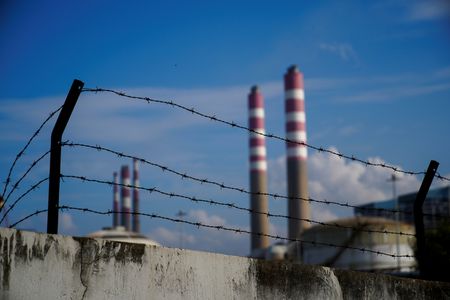By Colleen Howe
BEIJING (Reuters) -Thermal power generation in China, fuelled mainly by coal, fell 2.3% in April and 4.1% from January to April amid slower overall power output growth, official data showed on Monday, in line with expectations that China’s fossil-fuelled electricity could dip in 2025 for the first time in a decade.
Total power generation rose 0.9% in April to 711.1 billion kWh, slower than 1.8% in March, data from the National Bureau of Statistics (NBS) showed.
“April coincided with escalating trade disputes, which may have impacted manufacturing electricity consumption,” LSEG senior research specialist Xuewan Chen said.
But she said industry-specific data would be needed to confirm the impact of the U.S.-China trade dispute, which has been dialed back for 90 days after both sides on May 12 agreed to slash their reciprocal tariffs for an initial period.
Analysts said slowing factory output growth figures on Monday showed the impact of the trade war on China’s industrial sector, which makes up close to 65% of power demand.
Above-normal temperatures in most regions in China in April also kept demand for heating capped, contributing to the slower growth, Chen said.
The unseasonably warm winter meant power generation for the first four months of the year edged up just 0.1% to 2.98 trillion kWh. Fuller data will be released later in the month by the National Energy Administration (NEA).
The NBS figures understate total generation because they do not count some small-scale renewable generators, in line with survey requirements to include only industrial firms with at least 20 million yuan ($2.8 million) of annual revenue from their main operations.
Figures from the energy regulator illustrate the discrepancy; for example, NEA reported that power consumption rose 4.8% in March while NBS figures showed 1.8% output growth.
Power output and consumption usually grow at a similar rate, analysts say, though there may be discrepancies due to transmission loss and other factors.
Industry body, the China Electricity Council, said in its most recent report last month that power consumption was expected to grow 6% year-on-year in 2025, nearing 2024’s 6.8% growth level, but added that its forecasts were currently “not considering the impact of the worsening global trade environment”.
Hydropower, China’s second-largest power source, meanwhile fell 6.5% to 78.6 billion kWh in April, the NBS data showed, as parts of Sichuan and Yunnan provinces, where much of China’s hydropower capacity is located, have been facing drought conditions, according to state media. In the first four months of the year, hydropower output rose 2.2%.
(Reporting by Colleen Howe; Editing by Lincoln Feast, Kate Mayberry and Sharon Singleton)











